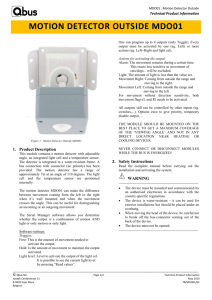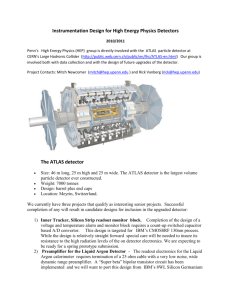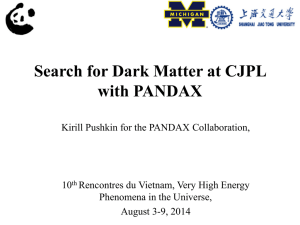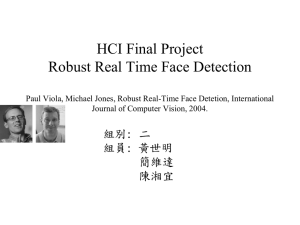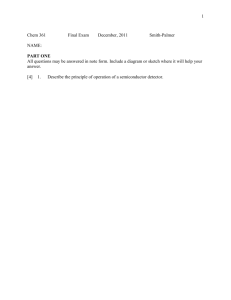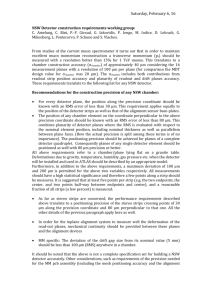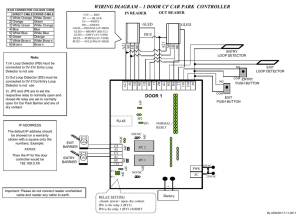lindsey_lab4_presentation
advertisement
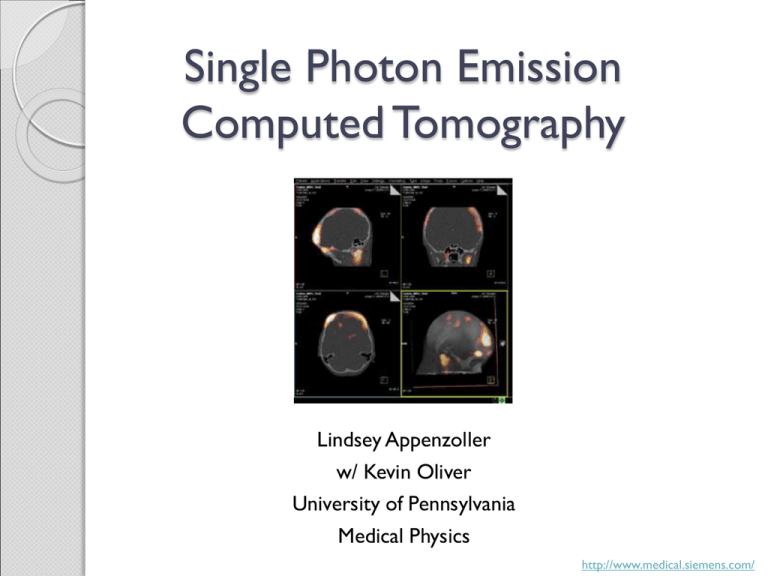
Single Photon Emission Computed Tomography Lindsey Appenzoller w/ Kevin Oliver University of Pennsylvania Medical Physics http://www.medical.siemens.com/ Introduction - SPECT • Detect single photons emitted by radionuclide tracers • 99mTc emits 140.5 keV gamma rays as it decays • Determine the origin and direction of emitted gamma • Reconstruct 3D images of the source or anatomy • Used as a diagnostic tool to image tumors, disease, and perform bone scans 99mTc Source and Phantom • Aqueous solution of 99mTc with initial activity ~ 318 μCi placed in a cylindrical phantom • Two positions for source: • Axis of phantom • ~ 9 cm above the axis • Decay detected by triple-headed gamma camera Detector Schematic Data collection • Four scans performed: • Center in air • Off-center in air • Center in water • Off-center in water • Each scan acquires data over 360 ° • Steps of 3 ° • 120 ° rotation of the scanner • Data collected for 15 seconds at each detector angle • Collected data is in the form of counts Detector Coordinate System • Detector rotates around the coordinate system of the source and phantom • Interested in the x’ coordinate in the detector reference frame • Coordinate system of detector: • x’: 256 bins • z’: 128 bins • Bin dimensions => 1.78 x 1.78 mm Centroid Determination Source projections at 0° and 90° • Determine centroid of projection for each detector angle using: where , • Uncertainty in centroid position: where • Plot centroid position vs. angle to determine initial source positions • Traces out sine curve Example of Sinogram Fit: Position: r = -98.9 ± 0.05 mm ϕ0 = 2.5 ± 0.02 ° Initial Position of Source Scan 1: Scan 2: Position of Center Source in Air Position (mm) σ (mm) x1 -4.45 0.03 y1 10.31 0.03 Scan 3: Position of Off-Center Source in Air Position (mm) σ (mm) x2 -4.31 0.04 y2 98.81 0.05 Scan 4: Position of Center Source in Water Position (mm) σ (mm) x3 -4.74 0.05 y3 6.28 0.05 Position of Off-Center Source in Water Position (mm) σ (mm) x4 -7.47 0.20 y4 91.25 0.23 Backprojection • Our projections represent the source distribution in the phantom for a single slice at every angle of the acquisition • Transform sinogram into the frequency domain to filter noise • Backproject counts (from centroid position) to get information about the spatial distribution of the source • Regions where backprojection lines from different angles intersect represent areas which contain a higher concentration of 99mTc Image Reconstruction • Use inverse radon transform on our total number of counts at each detector angle to reconstruct an image of the point source • Inverse radon transform filters noise from back projection • Example image reconstructions for source in water: Determine Path Length in Water • Emitted gamma travels a certain distance (L) through water to reach the detector at normal incidence • Use geometry to determine this path length (varies with angle) • Plot path length as a function of detector angle • Linear attenuation in water is governed by: • Account for continuous decay of source activity (Half life = 6.01 hrs) Plot of Path Length in Water Min: ϕ = 180° - Source closest to detector Max: ϕ = 0° - Source furthest from detector Linear Attenuation Coefficient • Plot attenuation (N/N0) vs. path length (L) to determine μ • Fit to linear curve: • Uncertainty in the attenuation is given by: • μ = 0.128 ± 0.001 cm-1 • Accepted value: μ = 0.15 cm-1 • Constant attributed to scatter in Lucite shell of phantom Questions?? ? ?


